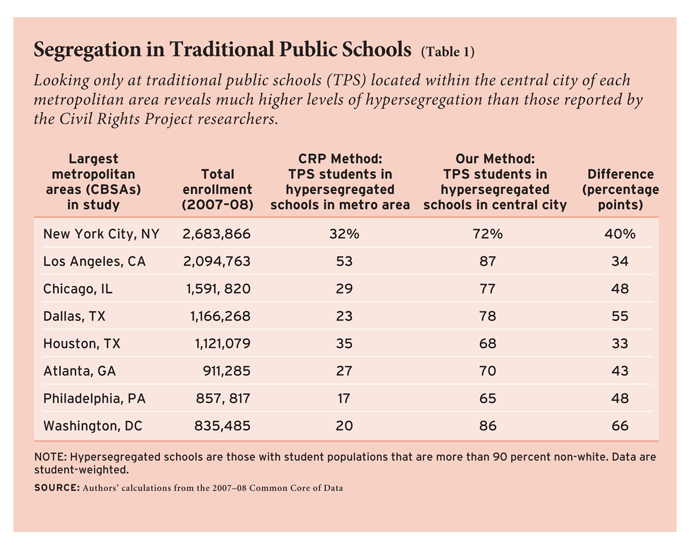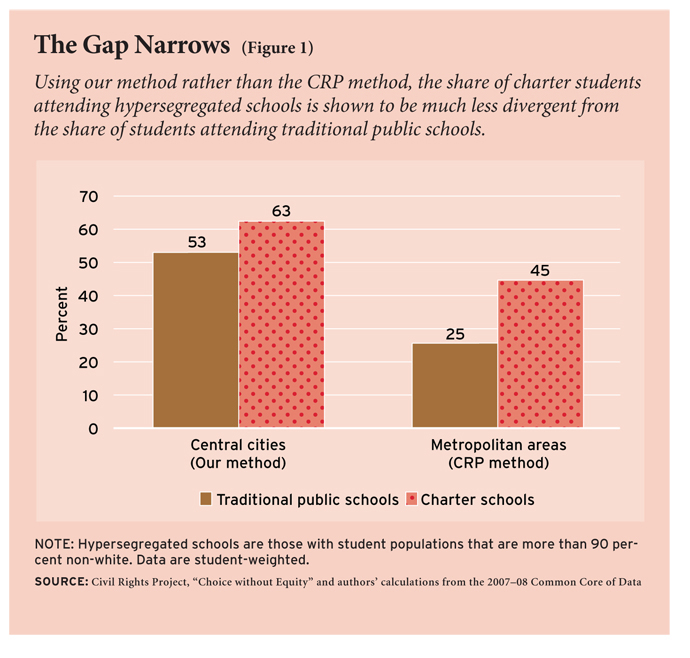 In January 2010, the UCLA-based Civil Rights Project (CRP) released “Choice without Equity: Charter School Segregation and the Need for Civil Rights Standards.” The study intended to report on, among other things, levels of racial segregation in charter schools across the United States. The authors use 2007–08 data from the U.S. Department of Education’s Common Core of Data (CCD) to compare the racial composition of charter schools to that of traditional public schools at three different levels of aggregation: nationwide; within 40 states and the District of Columbia; and within 39 metropolitan areas with large enrollments of charter school students. Based on these comparisons, the authors conclude, incorrectly in our view, that charter schools experience severe levels of racial segregation compared to traditional public schools (TPS).
In January 2010, the UCLA-based Civil Rights Project (CRP) released “Choice without Equity: Charter School Segregation and the Need for Civil Rights Standards.” The study intended to report on, among other things, levels of racial segregation in charter schools across the United States. The authors use 2007–08 data from the U.S. Department of Education’s Common Core of Data (CCD) to compare the racial composition of charter schools to that of traditional public schools at three different levels of aggregation: nationwide; within 40 states and the District of Columbia; and within 39 metropolitan areas with large enrollments of charter school students. Based on these comparisons, the authors conclude, incorrectly in our view, that charter schools experience severe levels of racial segregation compared to traditional public schools (TPS).
We will show that, when examined more appropriately, the data actually reveal small differences in the level of overall segregation between the charter school sector and the traditional public-school sector. Indeed, we find the majority of students in the central cities of metropolitan areas, in both charter and traditional public schools, attend school in intensely segregated settings. Our findings are similar to those in a 2009 report by RAND, in which researchers focused on segregation in five large metropolitan areas (Chicago, Denver, Milwaukee, Philadelphia, and San Diego) — areas that were also included in the CRP report. The RAND authors, with the benefit of student-level data, follow students who move from traditional public schools into charter schools and conclude that these transfers have “surprisingly little effect on racial distributions across the sites.” The authors of the RAND report write:
Across 21 comparisons (seven sites with three racial groups each), we find only two cases in which the average difference between the sending TPS and the receiving charter school is greater than 10 percentage points in the concentration of the transferring student’s race.
The RAND report, based on a superior methodology, provides strong evidence that the CRP claims are off base. Their findings, coupled with our own, offer a significantly different portrayal of segregation in charter schools than the CRP report. We find no basis for the allegations made by the CRP authors, who argue that charter-school enrollment growth, based on the free choices of mostly minority families, represents a “civil rights failure.”
While we find fault with the methodology employed by the CRP authors, and with their conclusions, we recognize that the questions addressed by the CRP, in this report and in scores of earlier ones, concern issues of importance for policymakers and the public alike. With the billions of dollars invested each year in public schools, both traditional and charter, and the millions of hours that we compel our children to attend these schools, it is critical that we have a basic understanding of the school environment that we are providing. Moreover, given the history of forced racial segregation in our nation’s schools, we must be ever-attentive to these issues.
Indeed, because these questions are of such significance, it is imperative that they be addressed carefully and correctly.
The Wrong Approach
Unfortunately, the analyses employed in the CRP report do not meet this standard. The authors begin by presenting a great deal of descriptive data on the overall enrollment and aggregate racial composition in public charter schools compared to traditional public schools. Based only on enrollments aggregated to the national and state level, the authors repeatedly highlight the overrepresentation of black students in charter schools in an attempt to portray a harmful degree of segregation. But comparisons of simple averages at such a high level of aggregation can obscure wide differences in school-level demographics among both charter and traditional public schools. It is like having your feet in the oven and your head in the icebox, and saying that, on average, the temperature is just right.
After this descriptive overview, the authors address the question of racial segregation in a more appropriate way. In this analysis, the CRP authors define as “hypersegregated” any school with a 90 percent minority population or a 90 percent white population. Their aim is to determine if charter students nationwide are more or less likely to attend school in such hypersegregated environments. However, a critical flaw undermines this comparison and all of the analyses that follow. In every case, whether the authors examine the numbers at the national, state, or metropolitan level, they compare the racial composition of all charter schools to that of all traditional public schools. This comparison is likely to generate misleading conclusions for one simple reason, as the authors themselves point out on the first page of the executive summary and then again on page 57 of the full report: “the concentration of charter schools in urban areas skews the charter school enrollment towards having higher percentages of poor and minority students.”
In other words, the geographic placement of charter schools practically ensures that they will enroll higher percentages of minorities than will the average public school in the nation, in states, and in large metropolitan areas. Further, because serving disadvantaged populations is the stated mission of many charter schools, they seek out locations near disadvantaged populations intentionally. Instead of asking whether all students in charter schools are more likely to attend segregated schools than are all students in traditional public schools, we should be comparing the racial composition of charter schools to that of nearby traditional public schools. Employing this method, we could compare the levels of segregation for the students in charter schools to what they would have experienced had they remained in their residentially assigned public schools.
If we acknowledge this standard for valid comparisons, we can quickly dismiss the national and state-level comparisons, which constitute the bulk of the CRP report. According to the authors’ own numbers in Table 20, more than half (56 percent) of charter school students attend school in a city, compared to less than one-third (30 percent) of traditional public school students. Thus, any national comparisons are inappropriate, as these two groups of students are inherently dissimilar. The authors employ this same flawed strategy individually for each of the 40 states included in their analysis. Again, comparing the segregation in charter schools in a state, which are concentrated in heavily minority central cities, to that in traditional public schools throughout the state, reveals nothing about the reality of racial segregation in charter schools.
The examples that the authors draw from these state-level comparisons are almost humorous at times. For example, consider the following point from page 43 of the report:
In some cases, like Idaho, charter school students across all races attend schools of white isolation: majorities of students of all races are in 90–100% white charter schools.
No kidding! The state of Idaho is nearly 95 percent white. Obviously, this is not a charter phenomenon, yet the authors brazenly use this as evidence for their claims without making any mention of the corresponding figure for the traditional public schools in the state.
Finally, the authors consider the hypersegregation in charter and traditional public schools individually within 39 metropolitan areas. But even within the large Census Bureau–defined Core-Based Statistical Areas (CBSAs) used as proxies for metropolitan areas, charters are still disproportionately located in low-SES (socioeconomic status) urban areas, while traditional public schools are dispersed throughout the entire CBSA. For example, the authors note that in the Washington, D.C., CBSA, 91 percent of students in charter schools attend hypersegregated schools, while only 20 percent of students in that same area attend hypersegregated traditional public schools. A quick look at the geographical placement of charter schools in the D.C. metro area, however, shows why such a comparison is inappropriate. The D.C. metro CBSA contains 1,186 traditional public schools, 1,026 of which are in Virginia, Maryland, and even West Virginia; only 13 percent of the traditional public schools in the D.C. CBSA are actually situated in the racially isolated District of Columbia. On the other hand, 93 percent of the charter schools in the D.C. CBSA are located in D.C. In other words, nearly all of the area’s charter schools are in D.C., while the vast majority of the traditional public schools the authors use in their comparisons are located in the largely suburban or exurban areas of surrounding states. For the 39 CBSAs examined by the authors, only 22 percent of the traditional public schools were located in central cities, compared to 51 percent of the charter schools.
A Tighter Comparison
It is indeed likely that, with the right analysis and the proper questions, the conclusion would not be as clear as portrayed by the CRP authors. We modified the CRP analysis by comparing the percentage of students in hypersegregated minority charters within the central city of each CBSA to the percentage of students in hypersegregated minority traditional public schools within the same central city. For example, for the Washington, D.C., CBSA, we included only schools located within the District of Columbia. The data we obtained for this comparison are publicly available from the Common Core of Data, so the CRP researchers could have conducted their analysis at this level. Of course, even this analysis is not perfect. Only following students at the individual level would reveal precisely what effect charters are having on segregation.
 We focus our reanalysis on the data presented by the authors in their report, (Table 10). The focal measures in this table are shown in the last two columns, where the authors present the percentage of charter school students (from the entire metropolitan area) in schools with greater than 90 percent minority students alongside the similar figure for traditional public schools. The problematic figure in this table is the percentage of traditional public school students in hypersegregated schools used as the point of comparison. (See Table 1) which shows the bias entailed for the 8 largest metropolitan areas by the CRP report.
We focus our reanalysis on the data presented by the authors in their report, (Table 10). The focal measures in this table are shown in the last two columns, where the authors present the percentage of charter school students (from the entire metropolitan area) in schools with greater than 90 percent minority students alongside the similar figure for traditional public schools. The problematic figure in this table is the percentage of traditional public school students in hypersegregated schools used as the point of comparison. (See Table 1) which shows the bias entailed for the 8 largest metropolitan areas by the CRP report.
Whether or not we believe that charter schools are more segregated than traditional public schools depends largely on which set of traditional public schools serve as a comparison. The data for these eight very large metropolitan areas, representing more than half of the enrollment for the entire dataset, demonstrate how the CRP method overstates the relative levels of segregation in the charter sector. For example, under the CRP method, 91.2 percent of the charter students in the DC CBSA are in hypersegregated minority schools, as compared to just 20.9 percent of the students in traditional public schools. Using the central-city method, the percentage of students in hypersegregated minority charters stays roughly the same, but the percentage of students in hypersegregated minority traditional publics skyrockets to 85 percent.
 In fact, in the vast majority of the 39 metro areas reviewed in the CRP report, the application of our central-city comparison decreases (relative to the flawed CRP analysis) the level of segregation in the charter sector as compared to the traditional public school sector. (Click here to view a table with these figures for all 39 CBSAs.) Importantly, unlike the CRP authors, we also compute and present the overall average results. Using the best available unit of comparison, we find that 63 percent of charter students in these central cities attend school in intensely segregated minority schools, as do 53 percent of traditional public school students (see Figure 1). Thus, while it appears that charter students are, on average, more likely to attend hypersegregated minority schools, the difference between the charter and traditional public sector is far less stark than the CRP authors suggest.
In fact, in the vast majority of the 39 metro areas reviewed in the CRP report, the application of our central-city comparison decreases (relative to the flawed CRP analysis) the level of segregation in the charter sector as compared to the traditional public school sector. (Click here to view a table with these figures for all 39 CBSAs.) Importantly, unlike the CRP authors, we also compute and present the overall average results. Using the best available unit of comparison, we find that 63 percent of charter students in these central cities attend school in intensely segregated minority schools, as do 53 percent of traditional public school students (see Figure 1). Thus, while it appears that charter students are, on average, more likely to attend hypersegregated minority schools, the difference between the charter and traditional public sector is far less stark than the CRP authors suggest.
The Right Question
Our analysis presents a more accurate, but still imperfect, picture of the levels of racial segregation in the charter sector relative to the traditional public-school sector. Ideally, to examine the issue of segregation, we would pose the question, Are the charter schools that students attend more or less segregated than the traditional public schools these students would otherwise attend? Unfortunately, our data linking schools to cities do not allow for this analysis.
Even within many of the central cities in the metropolitan areas listed above, there is a great deal of racial segregation. And most available data suggest that charter schools are popping up in areas where the students are poor and disadvantaged and need additional educational options. Public charter schools are simply less likely to open in economically advantaged, mostly white neighborhoods. Thus, even our analysis likely underestimates the true levels of racial segregation in the specific traditional public schools that charter students are leaving. Indeed, a more fine-grained analysis (similar to the study conducted by RAND) in which we compared the levels of segregation in public charter schools to that of the traditional public schools in the same neighborhood would be preferable. The RAND report is particularly relevant here because it focuses on student-level data from Chicago, Denver, Milwaukee, Philadelphia, and San Diego, five metropolitan areas highlighted in the CRP report. By examining student-level transfers, the authors are able to determine the extent to which students move into schools with higher concentrations of their own race and thereby increase the overall level of segregation. Using this strategy, the RAND researchers found,
Transfers to charter schools did not create dramatic shifts in the sorting of students by race or ethnicity in any of the sites included in the study. In most sites, the racial composition of the charter schools entered by transferring students was similar to that of the TPSs from which the students came.
Our own similar analysis of student-level transfers to charters in the Little Rock, Arkansas, area over the past five years tells much the same story. While many of the students transferred into Little Rock charter schools that were racially segregated, these students generally left traditional public schools that were even more heavily segregated.
Conclusion
The authors of the Civil Rights Project report conclude,
Our new findings demonstrate that, while segregation for blacks among all public schools has been increasing for nearly two decades, black students in charter schools are far more likely than their traditional public school counterparts to be educated in intensely segregated settings.
Our analysis suggests that these claims are certainly overstated. Furthermore, the authors fail to acknowledge two significant truths.
First, the majority of students in central cities, in both the public charter sector and in the traditional public sector, attend intensely segregated minority schools. Neither sector has cause to brag about racial diversity, but it seems clear that the CRP report points its lens in the wrong direction by focusing on the failings of charter schools. As the authors themselves note, across the country only 2.5 percent of public school children roam the halls in charter schools each day; the remaining 97.5 percent are compelled to attend traditional public schools. And we know that, more often than not, the students attending traditional public schools in cities are in intensely segregated schools. If we are truly concerned about limiting segregation, then this is where we should look to address the problem.
Second, and perhaps more important, the fact that poor and minority students flee segregated traditional public schools for similarly segregated charters does not imply that charter school policy is imposing segregation upon these students. Rather, the racial patterns we observe in charter schools are the result of the choices students and families make as they seek more attractive schooling options. To compare these active parental choices to the forced segregation of our nation’s past (the authors of the report actually call some charter schools “apartheid” schools) trivializes the true oppression that was imposed on the grandparents and great-grandparents of many of the students seeking charter options today.
Gary Ritter is professor of education policy at the University of Arkansas. Nathan Jensen, Brian Kisida, and Joshua McGee are research associates in the Department of Education Reform at the University of Arkansas.


